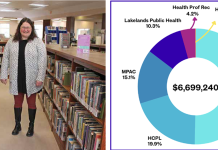Haliburton County’s lake health citizen scientists received some timely advice from Hutchinson Environmental Sciences Ltd. (HESL) and the Coalition of Haliburton Property Owners Associations (CHA), during a gathering at Sir Sam’s Ski/Ride May 6.
CHA hired HESL to do a water quality monitoring program design for its 51 property owners’ associations.
“Lakes in Haliburton County are relatively pristine,” said authors Kris Hadley and Joel Harrison. “Major sources of impacts are faulty septic systems, road salt, and climate change.
“The risks associated with contaminants may be minimal, and sampling may not be necessary, however emerging issues such as calcium decline, chloride from road salt, and blooms in low nutrient lakes are a concern now and moving forward and therefore monitoring programs should be developed with these stressors and emerging issues in mind,” the aquatic specialists said.
They suggested continuing to monitor for phosphorus, with 10 years or more of data to distinguish a trend from normal, year-to-year, variations. In addition, they recommended continued use of Secchi Depth for water clarity. Nearshore sampling of bacteria is urged, as is testing for water temperature and climate change indicators. HESL also said lake monitors should be on the look-out for dissolved oxygen and calcium and chloride numbers.
Outside of the core parameters, they said sampling of nitrogen, dissolved P, conductivity, dissolved organic carbon, alkalinity, pH, turbidity, metals, phytoplankton and emerging contaminants could be considered if the lake association has the resources.
As a guide, they suggested biweekly or monthly sampling between ice off and in, but acknowledged that might not be possible without enough volunteers.
The two noted that The Lake Partner Program (LPP) coordinated by the Ministry of the Environment, Conservation and Parks provides the best possible entry point to lake monitoring for lake associations with limited resources.
However, with greater time and money, water quality monitoring and assessment in cooperation with the LPP addresses several of the highest priority water quality issues in the Haliburton area, the said. These include phosphorus, calcium, and chloride.
“Lake associations interested in moving beyond data collection as part of the LPP are advised to seek lake specific guidance on the best allocation of resources from qualified experts, to ensure that specific equipment, training and analysis needs can be met, and resources are allocated efficiently,” HESL said. They offered some technology tips and costs as well as data management and storage suggestions.
The authors concluded that lakes in the County are under stress from a variety of emerging issues in water quality, such as changing climate, harmful algal blooms, invasive species, emerging contaminants, microplastic pollution, light and noise, salinization, declining calcium, engineered nanomaterials and cumulative impacts.
“The stressors on lakes in the Haliburton region are minimal compared to urban lakes but impacts from traditional stressors such as waterfront development are being combined with impacts associated with emerging issues such as climate change to create a myriad of biotic and abiotic changes in lakes.
“Insightful water quality monitoring programs are required to characterize water quality conditions now more than ever to characterize lake health, determine changes over time, and inform management options such as stewardship, related planning policy or active in-lake or watershed management.
“ CHA president Paul MacInnes said members should revisit their lake health monitoring. “As an example, the number two highest priority should now be ice watch. Benthics are now the second lowest priority.”
He further suggested associations double their efforts with regards to septic health, such as providing CHA septic tips to people around their lakes.
“Do what you can to avoid hydrologic overload. Lobby your mayor and council for a strong, short-term rental bylaw that limits occupancy to the number the septic system can handle. The CHA has rental posters.”
MacInness added, “let your mayor and council know you would like a standardized, countywide level 4 septic re-inspection system. Encourage folks to re-naturalize their shorelines. Join and support Safe Quiet Lakes.”




